opencv opens the camera and performs face detection
Development environment: Qt5.12.4, MSVC2017, win10
First, sort out the process
- Configure opencv Library in Qt
- Start a sub thread to continuously obtain image frames from the camera
- Use the obtained image frame to input opencv face recognition algorithm, and draw a rectangular box
- Transfer the image frame with face rectangular frame to the main interface for display
Create a widget project (preferably a QQuick project, which is just for the convenience of displaying the face detection effect, so create a widget project)
After creating the project, uncheck shadow build
 Then create four folders, debug, release, lib and resources, in the same level directory of the project. pro file.
Then create four folders, debug, release, lib and resources, in the same level directory of the project. pro file.

Then create two folders in the lib folder, opencvInclude and opencvlib
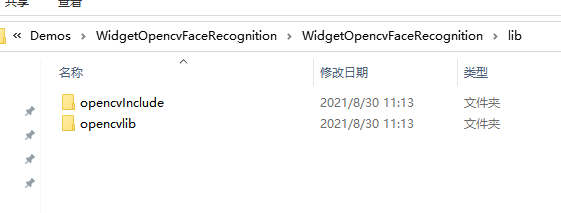
Qt configure openCV Library
The opencv version I use is 3.4.1, 64 bit, Click page to find opencv3.4.1
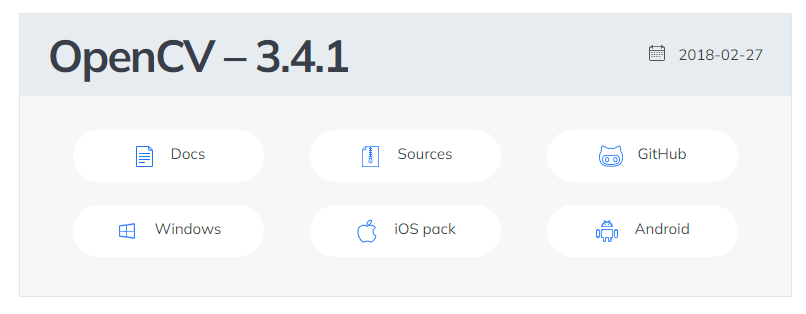
After downloading, install:
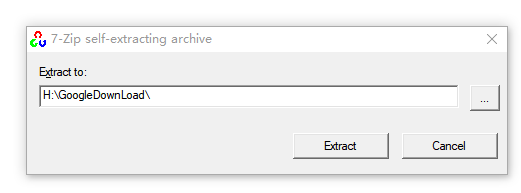
After installation, find the build folder in the installation path,

There is an X64 folder in the build folder. Go in and select the corresponding compiler version,
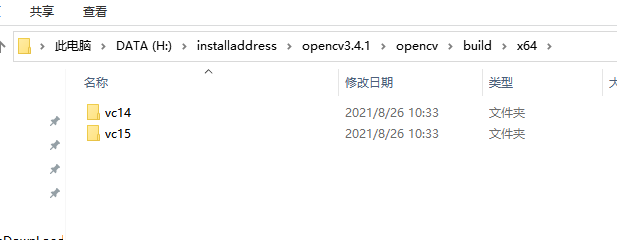
Here, I use MSVC2017, that is, VC15, and then find two libraries in the Lib folder in the next layer path. One is OpenCV_ World341.lib (the library used by release), and opencv_world341d.lib (the library used for debug).
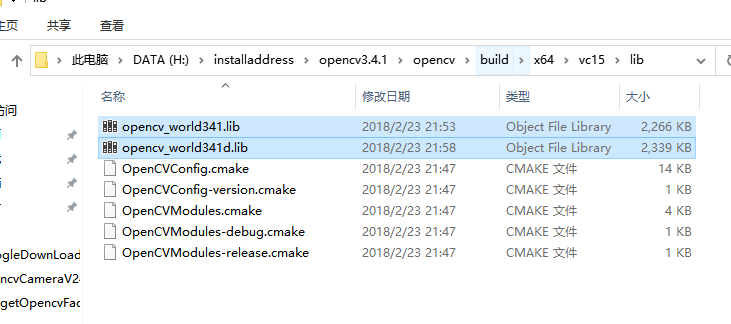
Copy the two libraries into the project directory lib/opencvlib

Then copy the two folders under build/include under the opencv3.4.1 installation path: opencv and opencv2 into lib/opencvinclude under the project directory
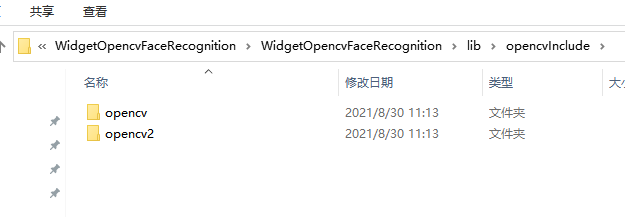
Then, two dynamic libraries under the build/x64/vc15/bin path under the opencv3.4.1 installation path: OpenCV_ World314.dll - > copy into the debug folder under the project path, opencv_ World314d.dll - > copy into the release folder under the project path,
Add face model xml file
Find the haarcascade under build/etc/haarcascades / in the opencv3.4.1 installation path_ frontalface_ Alt2.xml file, and then create the folder resources under the project path to haarcascade_ frontalface_ Copy alt2.xml to the Resources folder
###At this point, the required files are added!
Configuration. pro file
Add configuration information to the project. pro file as follows:
INCLUDEPATH += $$PWD/lib/opencvInclude
CONFIG( debug, debug | release ){
DESTDIR = $$PWD/debug
LIBS += -L$$PWD/lib/opencvlib -lopencv_world341d
}
CONFIG( release , debug | release ){
DESTDIR = $$PWD/release
LIBS += -L$$PWD/lib/opencvlib -lopencv_world341
}
#####So far, the opencv library has been configured
Next, start using opencv
Step 1: turn on the camera and get the image
Before writing this blog, I first used the Camera class of Quick to open the Camera and get images( Referring to this article, although it is an Android platform, it is almost the same as the development on windows)
Later, because the performance of the computer purchased by the company was too low, the Camera pictures provided by Quick were stuck, so opencv was used to open the Camera.
First, create a new class for human face detection
FaceRecognition.h
#ifndef FACERECOGNITION_H
#define FACERECOGNITION_H
#include <QObject>
#include <QDebug>
#include <QFile>
#include <QFileInfo>
#include <vector>
#include <QDateTime>
#include <iostream>
#include <QTimer>
#include "opencv2/opencv.hpp"
#include "opencv2/core.hpp"
#include "opencv2/objdetect/objdetect.hpp"
#include "opencv2/highgui/highgui.hpp"
#include "opencv2/imgproc/imgproc.hpp"
using namespace cv;
using namespace std;
class FaceRecognition : public QObject
{
Q_OBJECT
public:
explicit FaceRecognition(QObject *parent = nullptr);
//Initialize face recognition
void initFaceRecog();
//Initialization timer
void initTimer();
//Set the xml file of opencv face recognition library
bool setXmlFilePath( QString path );
//Get the path of opencv face recognition library file
QString getXmlFilePath();
//Set the value of the member variable m_objFrame
void setFrame( Mat frame );
// Use a rectangle to frame the face in the image
Mat paintRect( Mat frame );
//Get the number of faces
int getFaces();
//http flag bit, used to wait for the returned result
void setHttpAvalable( bool state );
//Get the flag bit result of http
bool getHttpAvailable();
signals:
public slots:
void onTimerTimeout();
private:
//Face classifier
CascadeClassifier m_objFace_cascade;
//Mat of opencv
Mat m_objFrame;
//xml file path of face recognition database
QString m_qsXmlFilePath;
//Store face frame
vector< Rect > m_veFaces;
//Whether to identify the flag bit
bool m_bRecognition;
//Number of faces
int m_iFaces;
//timer
QTimer m_timer;
// Flag bit waiting for http to return results
bool m_bHttpAvalable;
};
#endif // FACERECOGNITION_H
FaceRecognition.cpp
#include "FaceRecognition.h"
FaceRecognition::FaceRecognition(QObject *parent) : QObject(parent)
{
initFaceRecog();
initTimer();
}
void FaceRecognition::initFaceRecog()
{
m_bRecognition = true;
bool ok = setXmlFilePath( "../../resources/haarcascade_frontalface_alt2.xml" );
if( !ok )
{
qDebug() << " xml file not existed";
return;
}
//Load character training model
if( !m_objFace_cascade.load( m_qsXmlFilePath.toLocal8Bit().toStdString() ) )
{
qDebug() << " load xml file failed ";
return;
}
qDebug() << " load xml file success ";
}
void FaceRecognition::initTimer()
{
m_timer.setInterval( 300 );
connect( &m_timer, &QTimer::timeout, this, &FaceRecognition::onTimerTimeout );
m_timer.start();
}
bool FaceRecognition::setXmlFilePath( QString path )
{
QFile file( path );
QFileInfo fileInfo( file );
if( !fileInfo.exists() )
{
return false;
}
m_qsXmlFilePath = fileInfo.absoluteFilePath();
qDebug() << "xml path = " << m_qsXmlFilePath;
return true;
}
QString FaceRecognition::getXmlFilePath()
{
return m_qsXmlFilePath;
}
void FaceRecognition::setFrame( Mat frame )
{
if( frame.empty() )
{
qDebug() << " empty frame ";
return;
}
m_objFrame = frame;
}
Mat FaceRecognition::paintRect( Mat frame )
{
if( !m_bRecognition )
{
return frame;
}
setFrame( frame );
m_veFaces.clear();
Mat grayImg;
Mat outPutGrayImg;
Mat smallImg;
//Convert to grayscale
cvtColor( m_objFrame, grayImg, cv::COLOR_BGR2GRAY );
// resize( grayImg, smallImg, Size(), 0.9, 0.9, INTER_LINEAR );
//Histogram equalization to improve image quality
equalizeHist( grayImg, outPutGrayImg );
// cout<< " size = " <<outPutGrayImg.size() << endl;
// qint64 time1 = QDateTime::currentMSecsSinceEpoch();
//Start face detection. The Size will affect the performance of face detection. It is recommended to set the minimum Size slightly larger
m_objFace_cascade.detectMultiScale( outPutGrayImg, m_veFaces, 1.1, 3, 0, Size( 100, 100 ), Size( 300, 300 ) );
//Store the number of faces in the image to determine whether to send the image to the server through http in the run() function of DevCamera.cpp
m_iFaces = m_veFaces.size();
// qDebug() << " there are " << m_veFaces.size() << " faces ";
// qDebug() << QString( " coast %1 " ).arg( QDateTime::currentMSecsSinceEpoch() - time1 );
for( size_t i = 0; i < m_veFaces.size(); i++ )
{
Rect tmpFace = m_veFaces[ i ];
Point point1( tmpFace.x, tmpFace.y );
Point point2( tmpFace.x + tmpFace.width, tmpFace.y + tmpFace.height );
rectangle( m_objFrame, point1, point2, Scalar( 255, 0, 0 ) );
}
return m_objFrame;
}
int FaceRecognition::getFaces()
{
return m_iFaces;
}
void FaceRecognition::setHttpAvalable( bool state )
{
m_bHttpAvalable = state;
}
bool FaceRecognition::getHttpAvailable()
{
return m_bHttpAvalable;
}
void FaceRecognition::onTimerTimeout()
{
m_bRecognition = !m_bRecognition;
}
Then, create a new camera device class to obtain the camera image. Here, you need to start a new thread to continuously obtain the camera image. Transfer the face recognition class for face recognition and input the image with face box
DevCamera.h
#ifndef DEVCAMERA_H
#define DEVCAMERA_H
#include <QObject>
#include <iostream>
#include <QThread>
#include <QDebug>
#include <QMutex>
#include <QImage>
#include "opencv2/core/core.hpp"
#include "opencv2/highgui/highgui.hpp"
#include "opencv2/imgproc/imgproc.hpp"
#include "FaceRecognition.h"
class DevCamera : public QThread
{
Q_OBJECT
public:
DevCamera();
//Convert the Mat type of opencv to QImage
QImage matToQimage( Mat frame );
//The thread on which the QThread actually resides
void run();
//Turn off the camera
void closeCamera();
signals:
void signalNewQimageAvailable( QImage image );
void signalQimageToServer( QImage image );
private:
//Camera object
VideoCapture *m_pCamera;
//Camera operation flag bit
bool m_bCameraRunning;
//Wire program lock
QMutex m_objMutex;
//Path of opencv face recognition library file
QString m_objXmlPath;
//
QImage m_objQimg;
// Mat type of opencv
Mat m_objFrame;
//Face recognition class
FaceRecognition m_objFaceRecog;
};
#endif // DEVCAMERA_H
DevCamera.cpp
#include "DevCamera.h"
DevCamera::DevCamera()
{
m_pCamera = new VideoCapture();
}
void DevCamera::run()
{
if( !m_pCamera->isOpened() )
{
m_pCamera->open( 0 );
}
m_bCameraRunning = true;
while( true )
{
m_objMutex.lock();
if( !m_bCameraRunning )
{
m_objMutex.unlock();
break;
}
m_objMutex.unlock();
*m_pCamera >> m_objFrame;
//Face detection
m_objFrame = m_objFaceRecog.paintRect( m_objFrame );
QImage img = matToQimage( m_objFrame );
if( m_objFaceRecog.getFaces() > 0 )
{
emit signalQimageToServer( img );
}
emit signalNewQimageAvailable( img );
QThread::msleep( 20 );
}
m_pCamera->release();
m_bCameraRunning = false;
qDebug() << " break while ";
}
void DevCamera::closeCamera()
{
m_objMutex.lock();
m_bCameraRunning = false;
m_objMutex.unlock();
}
QImage DevCamera::matToQimage( Mat frame )
{
QImage img;
if (frame.channels()==3)
{
cvtColor(frame, frame, CV_BGR2RGB);
img = QImage((const unsigned char *)(frame.data), frame.cols, frame.rows,
frame.cols*frame.channels(), QImage::Format_RGB888);
}
else if (frame.channels()==1)
{
img = QImage((const unsigned char *)(frame.data), frame.cols, frame.rows,
frame.cols*frame.channels(), QImage::Format_ARGB32);
}
else
{
img = QImage((const unsigned char *)(frame.data), frame.cols, frame.rows,
frame.cols*frame.channels(), QImage::Format_RGB888);
}
return img;
}
Note!!!: to display an image, you only need to respond to the signalnewqimageavailable (IMG) signal of the DevCamera object!. in addition, opencv's face detection performance is relatively low. When recognizing a face, you'd better set a detection range: m_objface_cascade. Detectmultiscale (outputgrayimg, m_vefaces, 1.1, 3, 0, size (100, 100), size (300, 300)) The minimum identification size should be no less than 100 and the maximum should be no more than 400, otherwise the performance will be very low. I also add a timer here, which is set to detect once every 0.5 seconds, so as to help improve some performance.
The display effect is shown in the following figure:
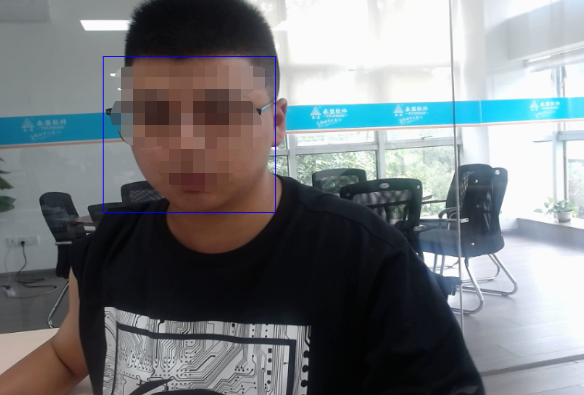
. the key code has ended here. Since I use the QML Image control to display images, but my project is a QWidget project, the rest of the code is used to embed QML into the QWidget, which has no impact on the identification part.